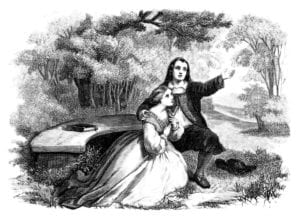The plays of Shakespeare were immensely popular in his own lifetime, drawing substantial audiences to the Globe Theatre by the Thames, and making him a great deal of money. They attracted people from every section of society, from the most impoverished to the most powerful. Many of these audiences were poorly-educated, and many not educated at all in any formal sense. Many would have been semi-literate. Yet they paid their penny at the gate to join the crowds who flocked to performances of “Henry V” and “Hamlet”, “Measure for Measure” and “Macbeth”. What drew them to these famously difficult plays? More importantly, how did they make sense of what they were watching on stage? How did they understand what they were seeing and hearing?
Part of the answer is that, though the audiences would not always have understood every word, they would still have been able to “get the gist” of what was being said. In fact we know that they didn’t understand every word, since Shakespeare loved to invent new words, so some of what the audiences heard must have been new to them. But some of what they saw on stage must also have been familiar, and we know this to be true, because of the parallels between some of Shakespeare’s work and the Morality Plays, which were a familiar feature of English life in the years before he was born, and which died out or were suppressed in their traditional form while he was still a child.
—
Medieval Morality Plays were a form of didactic street drama which aimed to present moral dilemmas through performance in a way that would help encourage Christian values among the general population. Theatre troupes that dramatized these stories moved from town to town, performing in inns, in guild halls, and in other public spaces. It seems likely that Shakespeare would have witnessed a troupe of this kind when he was a child, because Stratford was on the itinerary, and there are records of performances there when he was young. Plays of this type died out or were suppressed because those in authority believed that, with the Reformation and the end of Catholic England, times had changed, and different lessons needed to be taught. Moreover, a new secular and humanist drama was beginning to emerge, of which Shakespeare became in time a leading light.
But to say that the Morality Plays died out altogether is a simplification because some of their characteristics lived on in the drama that replaced them. That this includes the plays of Shakespeare becomes clear when we explore some of their typical features. As a general rule, they featured an Everyman figure, with whom the audience would identify as the story developed. They would often feature a positive or virtuous character, together with the opposite, a negative or sinful individual. This character was often known as the Vice, and he would be presented as persuasive, convincing and (in the words of the critic Frank Kermode) “engagingly wicked” and hard to resist. Often the Vice would address the audience directly, telling them how he meant to corrupt Everyman, bringing the audience into his world and his plans. Dramatic irony was central to the entertainment.
—
There are many examples of this kind of dynamic in Shakespeare’s plays, suggesting that though the Morality Plays died out, one of their central mechanisms survived intact. It can take many different forms, but the essential structure survives: an Everyman character is tempted by a version of the Vice, and succumbs to temptation. A familiar example is Macbeth. At first he is loyal and respected, and he values his good name and reputation. But his wife, beguiled by the witches’ prophecies that he will one day be king, persuades Macbeth to abandon his good reputation, and murder Duncan. Macbeth is weak and surrenders to her powerful influence, committing a crime which in the end brings him only misery.
A similar scene is played out in “Julius Caesar”. Here Cassius is plotting the assassination of the Roman leader because, he claims, Caesar is becoming too powerful. But he needs a popular and well-respected figurehead to lead the assault. Brutus, like Macbeth, is a kind of Everyman, and, like Macbeth, he’s initially reluctant to get involved. But Cassius works on him, flattering him and encouraging his ambitious spirit, and Brutus succumbs to temptation. Caesar, like Duncan, is stabbed to death, but by the play’s end, Brutus and Cassius (like Macbeth and his wife) are corpses, paying for their decisions with their lives.
A third example occurs in “the Tempest”. In this play a coterie of Italian aristocrats is marooned on what looks like a deserted island after a storm seems to sink their boat. In fact, their shipwreck is the work of the magician Prospero, whom they had slighted many years before. Now Antonio finds himself alone with Sebastian and encourages him to believe that if he kills his older brother Alonso, he will become the next King of Naples. Once again a stew of ambition, persuasion and assassination is being cooked up. “But, for your conscience?” asks Sebastian, but Antonio is dismissive: “I feel not / This deity in my bosom,” he replies, speaking for Lady Macbeth and Cassius too, perhaps. In the event their plans are interrupted by the arrival of Ariel, Prospero’s assistant and envoy, and the King of Naples narrowly avoids the fate that befell the King of Scotland and the Emperor of Rome.
—
There are many other examples, and they are often revealing. “Othello” offers a particularly vivid expression of the way many of the central characteristics of the Morality Play survived into the work of Shakespeare. In the first place, there is the Vice, in the person of Iago, given a Spanish name despite being (as he claims) a citizen of Venice born and bred. His naming represents a steer to the audience on the playwright’s part, because Spain was strongly associated with Catholicism, and besides, had been England’s most conspicuous enemy and rival for the past two decades. The audience is not intended to admire or respect Iago but they cannot ignore him, since he is given seven soliloquies in which to appraise spectators of his plans.
Then there is Everyman, in this case Othello, and this selection is striking, because Othello is from North Africa originally, his tenuous and ambiguous place in society symbolised by the play’s subtitle: The Moor of Venice. Evidently Shakespeare expected his audience to commit to Othello and identify with him, and it says much for him and his audience that the play has no power if we do not care what happens to its central character. But at first, before he is tempted and deceived, persuaded to destroy himself in destroying one he loves, he resembles Macbeth, a man of presence and integrity.
Finally comes the act of temptation and persuasion. Like Lady Macbeth with her husband and Cassius with Brutus, Iago is irresistible in the challenge he mounts to Othello’s sense of right and wrong. Moreover, it is the role of the Vice to operate under the eye of an audience that knows what he is doing, and this play is a prime example of the power of dramatic irony to frustrate an audience with the evidence of their own impotence. So while Othello is led to his self-inflicted doom, we can only marvel at Iago’s satanic cunning and the weakness of Everyman, his ability (in the words of Oscar Wilde) to resist everything except temptation. As he faces his fate in the last lines of the play – the same fate, of course, faced by Macbeth and Brutus – Othello claims that he “loved not wisely but too well”, but it would be more accurate to say that he trusted not wisely but too well, and in trusting the Vice, he was too easily deceived. The critic Brian Morris argues that Morality Plays are “concerned with presenting an audience with incitements to virtue and dissuasives from sin”, and the common fate of Macbeth, of Brutus and of Othello at the hands of (respectively) Lady Macbeth, Cassius and Iago is certainly dissuasive.
—–
Critics tend to summarise the essential structure of these plays in binary terms: good versus evil. “Man’s soul”, as Glynne Wickham puts it, becomes “the prime objective of both the forces of good and the forces of evil in the world”. One example of this binary structure emerges in the perhaps unlikely context of “Henry IV Part One”, where the soul in question belongs to the King’s son and heir Prince Hal. In the first scene of the play, the King is preoccupied with two challenges: he wants to lead a Christian crusade to the Holy Land in pursuit (as he sees it) of his Christian duty; and he wants to reform the behaviour of his son. In the second scene, we meet Prince Hal himself, along with his engaging, slothful, dishonest but nonetheless irresistible companion Falstaff. Falstaff is presented planning a robbery of some Christian pilgrims he knows to be en route to Canterbury, and Prince Hal is busy planning a practical joke on Falstaff that will not save the Christian pilgrims, but will nonetheless prove amusing.
The contrast between the two father-figures and their take on Christian duty does not need to be elaborated, but it is one of the more prominent themes of the play, and of its sequel, “Henry IV Part Two”. Here again a contrast is drawn between “the forces of good and the forces of evil”, though now Falstaff has a more formidable opponent than the late King in the person of the incorruptible Lord Chief Justice. As his influence over Prince Hal increases, so Falstaff’s declines, to the point where, in the climactic closing scene, Falstaff is rejected: “I know thee not, old man”, says Prince Hal, and the Lord Chief Justice brings matters to a close by ordering Falstaff incarcerated in Fleet Prison.
—–
It seems likely that Shakespeare was influenced in creating these very diverse texts by a play composed by his model and rival Christopher Marlowe, which was written and performed while Shakespeare was still perfecting his own craft. The central character of “Dr Faustus” (written around 1592) has given up his life to his hunger for knowledge, but his appetite has now been satisfied, and when two angels (known as the Good Angel and the Bad Angel, reflecting the binary nature of the legacy of the Morality Play) contend for his soul, it is the Bad Angel who triumphs. Faustus renounces his Christianity and strikes a deal with the devil, to enjoy infinite power for twenty-four years in exchange for his soul. The play ends with Faustus bitterly regretting his choice. It is fair to call “Dr Faustus” a kind of updated Morality Play because it draws closely on many of the conventions of this type of text: the Everyman who is vulnerable to temptation, the Vice who has his ear, the fate that serves as the dissuasive. If we are to draw a direct line from the Morality Plays to Shakespeare, we should probably insert the name of Marlowe into the family tree.
But perhaps the real origins of the Morality Plays may be traced much further back, to the episode in the New Testament known as the Temptation of Christ, in which the Devil tries to win the son of God to his cause with bribes and blandishments. Christ’s response – “Get thee behind me, Satan” – so closely echoes King Henry V’s curt rejoinder to Falstaff – “I know thee not, old man” – that this rejection and the Biblical episode it evokes were surely not just deliberate but also powerful and graphic in what was implied. There is something of the Devil in the Vice, and thus we are brought back to the Morality Plays of fifty years before.
It seems likely that, saturated in Christian culture and learning, Shakespeare’s audiences would have been acutely sensitive to what we might call the narrative archetypes being presented to them in plays like those discussed here. True, “Henry IV Parts One and Two” (1597) are very different from the gloomier tragedies – “Othello” (1604), perhaps, or “Macbeth” (1605) – which played at the Globe a few years later. But the range and variety of the plays in which Everyman is confronted with the Vice – at times innocently, at others less admirably – is evidence in itself of the flexibility of the trope which had been a central ingredient of the street theatre of Shakespeare’s youth.
The Morality Plays themselves evidently have origins of their own, though there are 1500 years between the Temptation of Christ and the temptation of Prince Hal at the hands of Falstaff. Nonetheless, in its essential structure, the Biblical narrative that presents Jesus Christ alone in the desert, tempted by the devil, and rejecting his blandishments, has a clear didactic force, its impact echoing in the new world of the Elizabethan theatre.




